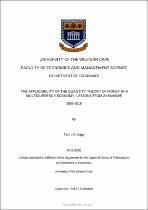| dc.contributor.advisor | Sheefeni, Johannes | |
| dc.contributor.author | Chivige, Tariro | |
| dc.date.accessioned | 2022-08-02T07:50:03Z | |
| dc.date.available | 2022-08-02T07:50:03Z | |
| dc.date.issued | 2022 | |
| dc.identifier.uri | http://hdl.handle.net/11394/9187 | |
| dc.description | Magister Commercii - MCom | en_US |
| dc.description.abstract | One of the first economic theories to ever study the effects of money on price levels is the
Quantity Theory of Money (QTM). Both traditionally and empirically, the tenets of this study
have been studied in mono currency economies. However, due to the ever-changing modernday
economies, countries suffering from intense economic problems like inflation have
abandoned the use of their own local currencies opting to use multiple foreign currencies as
legal tender. This study explores the applicability of the Quantity Theory of Money in a
multicurrency economy, a yawning gap in scholarship. More so, no studies have sought to
simultaneously look at the different approaches to the QTM in one study to establish their
applicability in a multicurrency economy. | en_US |
| dc.language.iso | en | en_US |
| dc.publisher | University of the Western Cape | en_US |
| dc.subject | Foreign currency | en_US |
| dc.subject | Inflation | en_US |
| dc.subject | Multicurrency | en_US |
| dc.subject | Zimbabwe | en_US |
| dc.subject | Finance | en_US |
| dc.title | The applicability of the quantity theory of money in a multicurrency economy: Lessons from Zimbabwe 2009-2019 | en_US |
| dc.rights.holder | University of the Western Cape | en_US |

